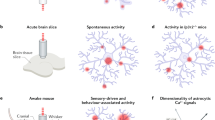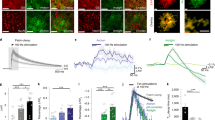Abstract
Rapid signal exchange between astroglia and neurons has emerged as a key player in neural communication in the brain. To understand the mechanisms involved, it is often important to have access to individual astrocytes while monitoring the activity of nearby synapses. Achieving this with standard electrophysiological tools is not always feasible. The protocol presented here enables the monitoring of synaptic activity using whole-cell current-clamp recordings from a local astrocyte. This approach takes advantage of the fact that the low input resistance of electrically passive astroglia allows extracellular currents to pass through the astrocytic membrane with relatively little attenuation. Once the slice preparation is ready, it takes ∼30 min to several hours to implement this protocol, depending on the experimental design, which is similar to other patch-clamp techniques. The technique presented here can be used to directly access the intracellular medium of individual astrocytes while examining synapses functioning in their immediate proximity.
This is a preview of subscription content, access via your institution
Access options
Subscribe to this journal
Receive 12 print issues and online access
$259.00 per year
only $21.58 per issue
Buy this article
- Purchase on Springer Link
- Instant access to full article PDF
Prices may be subject to local taxes which are calculated during checkout






Similar content being viewed by others
References
Haydon, P.G. Glia: listening and talking to the synapse. Nat. Rev. Neurosci. 2, 185–193 (2001).
Volterra, A. & Meldolesi, J. Astrocytes, from brain glue to communication elements: the revolution continues. Nat. Rev. Neurosci. 6, 626–640 (2005).
Nedergaard, M., Rodriguez, J.J. & Verkhratsky, A. Glial calcium and diseases of the nervous system. Cell Calcium 47, 140–149 (2010).
Perea, G. & Araque, A. Glia modulates synaptic transmission. Brain Res. Rev. 63, 93–102 (2010).
Han, J. et al. Acute cannabinoids impair working memory through astroglial CB1 receptor modulation of hippocampal LTD. Cell 148, 1039–1050 (2012).
Navarrete, M. et al. Astrocytes mediate in vivo cholinergic-induced synaptic plasticity. PLoS Biol. 10, e1001259 (2012).
Takata, N. et al. Astrocyte calcium signaling transforms cholinergic modulation to cortical plasticity in vivo. J. Neurosci. 31, 18155–18165 (2011).
Hamilton, N.B. & Attwell, D. Do astrocytes really exocytose neurotransmitters? Nat. Rev. Neurosci. 11, 227–238 (2010).
Kang, J., Jiang, L., Goldman, S.A. & Nedergaard, M. Astrocyte-mediated potentiation of inhibitory synaptic transmission. Nat. Neurosci. 1, 683–692 (1998).
Pascual, O. et al. Astrocytic purinergic signaling coordinates synaptic networks. Science 310, 113–116 (2005).
Serrano, A., Haddjeri, N., Lacaille, J.C. & Robitaille, R. Gabaergic network activation of glial cells underlies hippocampal heterosynaptic depression. J. Neurosci. 26, 5370–5382 (2006).
Navarrete, M. & Araque, A. Endocannabinoids mediate neuron-astrocyte communication. Neuron 57, 883–893 (2008).
Navarrete, M. & Araque, A. Endocannabinoids potentiate synaptic transmission through stimulation of astrocytes. Neuron 68, 113–126 (2010).
Agulhon, C. et al. What is the role of astrocyte calcium in neurophysiology? Neuron 59, 932–946 (2008).
Perea, G., Navarrete, M. & Araque, A. Tripartite synapses: astrocytes process and control synaptic information. Trends Neurosci. 32, 421–431 (2009).
Panatier, A. et al. Astrocytes are endogenous regulators of basal transmission at central synapses. Cell 146, 785–798 (2011).
Bergles, D.E. & Jahr, C.E. Synaptic activation of glutamate transporters in hippocampal astrocytes. Neuron 19, 1297–1308 (1997).
Bergles, D.E. & Jahr, C.E. Glial contribution to glutamate uptake at Schaffer collateral-commissural synapses in the hippocampus. J. Neurosci. 18, 7709–7716 (1998).
Diamond, J.S., Bergles, D.E. & Jahr, C.E. Glutamate release monitored with astrocyte transporter currents during LTP. Neuron 21, 425–433 (1998).
Luscher, C., Malenka, R.C. & Nicoll, R.A. Monitoring glutamate release during LTP with glial transporter currents. Neuron 21, 435–441 (1998).
Scimemi, A., Fine, A., Kullmann, D.M. & Rusakov, D.A. NR2B-containing receptors mediate cross talk among hippocampal synapses. J. Neurosci. 24, 4767–4777 (2004).
Steinhäuser, C., Berger, T., Frotscher, M. & Kettenmann, H. Heterogeneity in the membrane current pattern of identified glial cells in the hippocampal slice. Eur. J. Neurosci. 4, 472–484 (1992).
Henneberger, C., Papouin, T., Oliet, S.H. & Rusakov, D.A. Long-term potentiation depends on release of D-serine from astrocytes. Nature 463, 232–236 (2010).
Ge, W.P. & Duan, S.M. Persistent enhancement of neuron-glia signaling mediated by increased extracellular K+ accompanying long-term synaptic potentiation. J. Neurophysiol. 97, 2564–2569 (2007).
Tsukada, S., Iino, M., Takayasu, Y., Shimamoto, K. & Ozawa, S. Effects of a novel glutamate transporter blocker, (2S, 3S)-3-[3-[4-(trifluoromethyl)benzoylamino]benzyloxy]aspartate (TFB-TBOA), on activities of hippocampal neurons. Neuropharmacology 48, 479–491 (2005).
Molleman, A. Patch Clamping: An Introductory Guide to Patch Clamp Electrophysiology (Wiley & Sons, 2002).
Lein, P.J., Barnhart, C.D. & Pessah, I.N. Acute hippocampal slice preparation and hippocampal slice cultures. Methods Mol. Biol. 758, 115–134 (2011).
Anderson, P., Bliss, T.V. & Skrede, K.K. Lamellar organization of hippocampal pathways. Exp. Brain Res. 13, 222–238 (1971).
Teyler, T.J. Brain slice preparation: hippocampus. Brain Res. Bull. 5, 391–403 (1980).
Schwartzkroin, P.A. Characteristics of CA1 neurons recorded intracellularly in the hippocampal in vitro slice preparation. Brain Res. 85, 423–436 (1975).
Scott, R., Ruiz, A., Henneberger, C., Kullmann, D.M. & Rusakov, D.A. Analog modulation of mossy fiber transmission is uncoupled from changes in presynaptic Ca2+. J. Neurosci. 28, 7765–7773 (2008).
Nimmerjahn, A., Kirchhoff, F., Kerr, J.N. & Helmchen, F. Sulforhodamine 101 as a specific marker of astroglia in the neocortex in vivo. Nat. Methods 1, 31–37 (2004).
Kang, K. & Song, M.R. Diverse FGF receptor signaling controls astrocyte specification and proliferation. Biochem. Biophys. Res. Comm. 395, 324–329 (2010).
Acknowledgements
This work was supported by the Human Frontier Science Programme, the Wellcome Trust (D.A.R.), the Medical Research Council (D.A.R.), a UCL Excellence Fellowship (C.H.) and the NRW-Rückkehrerprogramm (C.H.).
Author information
Authors and Affiliations
Contributions
C.H. carried out experimental studies; D.A.R. and C.H. designed the study, analyzed the data and wrote the paper.
Corresponding authors
Ethics declarations
Competing interests
The authors declare no competing financial interests.
Rights and permissions
About this article
Cite this article
Henneberger, C., Rusakov, D. Monitoring local synaptic activity with astrocytic patch pipettes. Nat Protoc 7, 2171–2179 (2012). https://doi.org/10.1038/nprot.2012.140
Published:
Issue Date:
DOI: https://doi.org/10.1038/nprot.2012.140
Comments
By submitting a comment you agree to abide by our Terms and Community Guidelines. If you find something abusive or that does not comply with our terms or guidelines please flag it as inappropriate.



